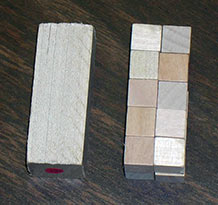How can centimeter cubes help us measure volume?
4. Measure the volume of the blocks
Distribute the sets of centimeter cubes to each group. Have the students work together to find a way to use the cubes to determine the correct volume order of the wooden blocks.

By building a replica of Block Busing centimeter cubes, students can see that the volume of the block is 20 cubic centimeters.
There may be stops and starts as students reveal their misconceptions about how to measure volume. For example, they may try to measure length and width, or they may surround the perimeter of a block with the centimeter cubes.
Measure: The most successful strategy is to use the cubes to replicate a block, and then count the cubes to determine the volume. If one group discovers this strategy, they can share it with the class. Make sure each student in a group measures the volume of at least one block, using the replication strategy. Then have the group establish the volume order of the blocks based on these measurements.
After everyone has recorded the measured order their notebook, ask one student to enter the “Measured Order” in the bottom row of the class table. Make sure the entry includes the unit of measure: cubic centimeters.
Does everyone agree on the measured volumes? How do the measurements compare to the “guesstimates”? Do students see how the opportunity to measure volume allows them to order the blocks even when the differences are very small?
Finally, ask students to add one set of the blocks to the volume order line.



